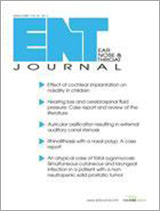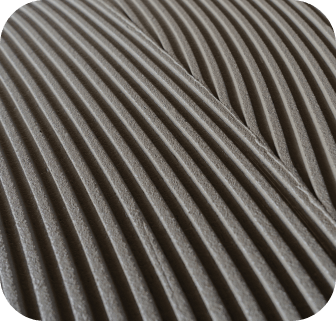
Bilateral auricular seromas: A case report and review of the literature
Abstract
Hematomas, pseudocysts, and seromas are all part of the differential diagnosis of auricular swellings. Seromas are benign collections of serous fluid that have a tendency to recur. The fluid accumulates in the space between the dermis and perichondrium of the ear. We describe what we believe is the first case of spontaneous bilateral auricular seromas to be reported in the literature. One of the seromas resolved in 4 weeks without treatment, and the other resolved with incision and drainage. It is important for physicians to be aware of auricular seromas when considering the differential diagnosis of an auricular swelling, and to understand the various treatment options.
by Shari D. Reitzen, MD, Stephen Rothstein, MD, and Anil R. Shah, MD
Introduction
Auricular seromas have only recently been discussed in the literature.1 These benign collections of serous fluid are part of the differential diagnosis of auricular swellings, along with hematomas and pseudocysts. Seromas have a tendency to recur.
Previous presentation: The information in this article has been updated from its original presentation as a poster at the annual fall meeting of the American Academy of Facial Plastic and Reconstructive Surgery; Sept. 18-21, 2008; Chicago.
Unlike the case with auricular hematomas, the fluid in auricular seromas is straw-colored and serous.1, 2 Furthermore, auricular hematomas are typically associated with a distinct history of definite trauma, while auricular seromas are associated with trivial trauma. A recent theory holds that auricular hematomas and seromas may represent two points along a continuum of the same process.1,2
In an auricular seroma, the fluid accumulates in the space between the dermis and perichondrium of the ear; changes in the cartilage are rare.1 Some physicians advocate leaving the seroma untouched, whereas others find it necessary to obtain a diagnosis and treat with aspiration alone or with a compressive dressing.
We describe what we believe is the first case of spontaneous bilateral auricular seromas to be reported in the literature.
Case report
A 19-year-old man presented with a 1-week history of a spontaneous collection of fluid in his right ear. The patient denied any trauma, but he was noted to be a “violent sleeper.” Of note, he said he had experienced a similar collection of fluid in his left ear 4 years earlier; the earlier collection had resolved spontaneously over a period of 4 weeks. He also reported a residual thickening over the helix where the collection had occurred.
On examination, a swelling with a bluish tinge to the skin was noted over the scaphoid fossa (figure 1). The mass was soft and fluctuant on palpation. The swelling was drained via needle aspiration, and the auricle returned to its original shape. Fluid was sent to pathology for analysis and culture. A compressive bolster of Telfa, secured with 2-0 nylon, was placed.
Figure 1. The initial right-sided seroma in the scaphoid fossa is seen at presentation.
Two days later, the patient returned because the fluid had reaccumulated around the scaphoid fossa, and he underwent a second needle aspiration. In addition to a compressive bolster, 20 quilting sutures were placed with Monocryl (figure 2, A). The bolster was removed 1 week later, the Monocryl sutures were removed 2 weeks later, and there was no further evidence of a seroma at that time (figure 2, B). On pathologic evaluation, the aspirated fluid contained scant histiocytes. The patient also underwent an immunologic workup that included measurements of antinuclear antibody, rheumatoid factor, erythrocyte sedimentation rate, and a complete blood count, all of which were normal.
Figure 2. A: The recurrent right-sided collection is seen after aspiration and placement of Monocryl quilting sutures. B: Two weeks later, no sign of the seroma is evident.
Four months later, the patient returned with a recurrence of fluid in his left ear. The fluid was aspirated, and quilting sutures and a bolster were placed. At the 1-year follow-up, he remained free of further auricular fluid collections.
Discussion
Auricular hematomas have been well defined in the literature.2 They are caused by a disruption of a blood vessel between the auricular cartilage and the perichondrium. These lesions occur in the upper anterior part of the auricle (mostly in the scaphoid fossa), and blood is encountered when the lesion is aspirated. Usually the swelling is associated with a history of trauma. On examination, these swellings are usually tender and fluctuant, and the overlying skin is erythematous. If a hematoma is not treated, an auricular deformity commonly known as “cauliflower ear” can occur as the degraded blood products in the subperichondrium induce destruction of cartilage.
Distinguishing auricular pseudocysts from auricular seromas can be difficult. Auricular pseudocysts contain a thicker, viscous, straw-colored fluid that accumulates intracartilaginously; there is no epithelial lining.1,3,4 Pseudocysts are fluctuant on examination, but they are firmer than hematomas because they are cartilaginous in nature. The development of auricular pseudocysts is believed to be a deeper process because they are embedded within the cartilage; auricular seromas are located between the skin and perichondrium.5
For treatment of pseudocysts and seromas, aspiration alone and incision and drainage have been described in the literature, but recurrence rates with these methods have been high.1,3,4 More aggressive methods have been proposed, including (1) incision and drainage with cyst curettage and a compressive dressing, (2) incision and drainage with intracavitary injection of iodine or trichloroacetic acid with or without bolster placement, (3) aspiration followed by intralesional and oral steroid administration, (4) aspiration with long-term placement of a custom bolster made of a prosthetic material, and (5) excision of the cyst and its wall.1,3,4,6-8
If left untreated, auricular pseudocysts can cause a deformity of the ear as the cartilage degenerates. Compared with seromas, auricular pseudocysts are much more disfiguring. The course of auricular seromas is typically more indolent, but in rare cases these lesions can cause cartilaginous change, as well. Both auricular pseudocysts and auricular seromas can recur, usually within a few weeks, with pseudocysts having a higher recurrence rate.1
There is much controversy regarding the management of auricular seromas.1 Although a definitive diagnosis cannot be made without aspiration of the cyst, many physicians advocate observation in the hope of spontaneous resolution. Others argue that aspiration or incision and drainage will shorten the disease period and allow for the fluid to be sent for pathologic evaluation. At different times, our patient experienced resolution both spontaneously and with treatment. To the best of our knowledge, ours is the first report of spontaneous bilateral auricular seromas.
Kikura et al analyzed 16 cases of auricular seroma and found that they occurred in patients without any history of trauma, insect bites, or bruising.1Accumulations were located in the plane between the dermis and perichondrium, and they arose most often between the antihelix and the concha. No signs of surrounding inflammation or tenderness were evident, and the seromas were either self-limited or were treated without causing a marked disfigurement (patients were followed for 1 to 2 years).
Two patients in the Kikura et al group had unique characteristics: 1 developed a double seroma in one ear, and the other had a seroma in the scaphoid fossa. All seromas were treated with aspiration, with a few patients requiring repeat aspiration and compressive bolster because of recurrences. Aspirations yielded a rose-, wine-, or straw-colored serum. Specimens sent for pathology contained few neutrophils and erythrocytes, and no bacteria were isolated.
It is important for physicians to be aware of auricular seromas when considering the differential diagnosis of an auricular swelling, and to understand the various treatment options.
From the Department of Otolaryngology, New York University School of Medicine, New York City (Dr. Reitzen and Dr. Rothstein); and the Division of Facial Plastic & Reconstructive Surgery, Department of Otolaryngology-Head & Neck Surgery, Manhattan Eye, Ear and Throat Hospital, New York City (Dr. Shah). The case described in this article occurred at the New York University School of Medicine.
Corresponding author: Shari D. Reitzen, MD, Department of Otolaryngology, NYU School of Medicine, 550 First Ave., NBV 5E5, New York, NY 10016. Email: [email protected]
References
- Kikura M, Hoshino T, Matsumoto M, et al. Auricular seroma: A new concept, and diagnosis and management of 16 cases. Arch Otolaryngol Head Neck Surg 2006; 132 (10): 1143-7.
- Giles WC, Iverson KC, King JD, et al. Incision and drainage followed by mattress suture repair of auricular hematoma. Laryngoscope 2007; 117 (12): 2097-9.
- Han A, Li LJ, Mirmirani P. Successful treatment of auricular pseudocyst using a surgical bolster: A case report and review of the literature. Cutis 2006; 77 (2): 102-4.
- Salgado CJ, Hardy JE, Mardini S, et al. Treatment of auricular pseudocyst with aspiration and local pressure. J Plast Reconstr Aesthet Surg 2006; 59 (12): 1450-2.
- Ichioka S, Yamada A, Ueda K, Harii K. Pseudocyst of the auricle: Case reports and its biochemical characteristics. Ann Plast Surg 1993; 31 (5): 471-4.
- Chang CH, Kuo WR, Lin CH, et al. Deroofing surgical treatment for pseudocyst of the auricle. J Otolaryngol 2004; 33 (3): 177-80.
- Job A, Raman R. Medical management of pseudocyst of the auricle. J Laryngol Otol 1992; 106 (2): 159-61.
- Miyamoto H, Oida M, Onuma S, Uchiyama M. Steroid injection therapy for pseudocyst of the auricle. Acta Derm Venereol 1994; 74 (2): 140-2.
Ear Nose Throat J. 2011 December;90(12):E12


